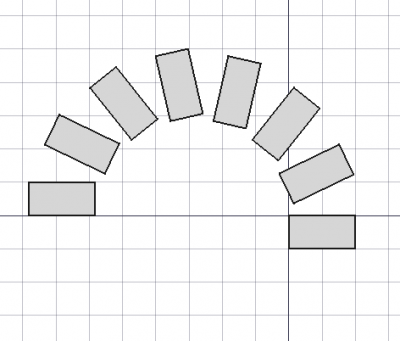Draft PolareAnordnung
|
Draft PolarAnordnung |
| Menüeintrag |
|---|
| Entwurf → Polare Anordnung |
| Arbeitsbereich |
| Entwurf |
| Standardtastenkürzel |
| Keiner |
| Eingeführt in Version |
| 0.19 |
| Siehe auch |
| Anordnung, KreisAnordnung, PfadAnordnung, Punkt Anordnung, Klonen |
Beschreibung
Das Entwurf PolarAnordnung Werkzeug erstellt eine Anordnung aus einem ausgewählten Objekt und platziert die Kopien entlang eines Umfangs.
Dieses Werkzeug kann für 2D Formen verwendet werden, die mit dem Entwurf Arbeitsbereich erstellt wurden, aber auch für viele Arten von 3D Objekten, wie sie mit der Part Arbeitsbereich oder PartDesign Arbeitsbereich erstellt wurden.
Zum Positionieren von Kopien in einem rechteckigen Raster verwende Array; zum Positionieren in einem kreisförmigen Muster verwende KreisAnordnung; um Kopien entlang eines Pfades zu positionieren, verwende PfadAnordnung; um Kopien an bestimmten Punkten zu positionieren, verwende PunktAnordnung; um Kopien oder Klone zu erstellen und manuell zu platzieren, verwende Bewegen, Drehen und Klonen.
A polar array of an object.
Usage
- Select an object from which you wish to make the polar array.
- Press the
Polar array button. If no object is selected, the task panel will open, but you still need to select an object to proceed.
- Choose the polar angle, which determines where the last element of the array will be.
- Choose the number of elements in the array. Minimum of 2, maximum of 99.
- Choose the center of the axis of rotation. You can click on the 3D view, to simultaneously set the position of the center of rotation, and complete the command.
- Optionally, check the fuse or link options.
- Press OK to complete the command.
Notes:
- By default, the axis of rotation is the positive Z axis
(0, 0, 1). This can be changed in the property editor after the object is created. - The polar angle is positive in the counter-clockwise direction, and negative in the clockwise direction.
- Each element in the array is an exact clone of the original object, but the entire array is considered a single unit in terms of properties and appearance.
- This command creates the same object as the one created with the Array and CircularArray tools. Therefore, the array can be converted to orthogonal, polar, or circular just by changing its properties.
Options
- Press Reset point to set the center of rotation to the origin
(0, 0, 0). - If the Fuse checkbox is ticked, the resulting objects in the array will be fused into a single shape, if they touch or intersect each other.
- If the Use Links checkbox is ticked, the resulting objects in the array will be App Links instead of simple copies. This improves the memory usage of the array, as the App Link re-uses the shape of the original object, and does not create new shapes. If this option is used, the Fuse checkbox has no effect.
- Press Esc or the Cancel button to abort the current command.
Properties
An Array object is based on Part Feature (Part::Feature class), and thus shares all properties of the latter. In addition to the properties listed in Part Feature, the Array object has additional properties.
See the OrthoArray tool for the complete information.
Scripting
See also: Draft API and FreeCAD Scripting Basics.
The Array tool can be used in macros and from the Python console by using the following function.
array_list = make_polar_array(obj, center, angle, number, use_link)
- Creates an array from the objects contained in
obj, which can be a single object or a list of objects. - The value of
centeris a vector that defines the center of the array circle;angleis the angle of the arc in degrees, andnumberis the number of copies in the polar pattern, including the original object. - If
use_linkistruethe created copies will be App Links and not regular copies. array_listis returned with the new copies.array_listis either a single object or a list of objects, depending on the inputobj.
Example:
import FreeCAD as App
import Draft
import draftobjects.polararray as pa
doc = App.newDocument()
tri = Draft.makePolygon(3, 600)
center = App.Vector(-1600, 0, 0)
arr = pa.make_polar_array(tri, center, 270, 8)
App.ActiveDocument.recompute()
- Drafting: Line, Polyline, Fillet, Arc, Arc by 3 points, Circle, Ellipse, Rectangle, Polygon, B-spline, Cubic Bézier curve, Bézier curve, Point, Facebinder, ShapeString, Hatch
- Annotation: Text, Dimension, Label, Annotation styles, Annotation scale
- Modification: Move, Rotate, Scale, Mirror, Offset, Trimex, Stretch, Clone, Array, Polar array, Circular array, Path array, Path link array, Point array, Point link array, Edit, Subelement highlight, Join, Split, Upgrade, Downgrade, Wire to B-spline, Draft to sketch, Set slope, Flip dimension, Shape 2D view
- Draft Tray: Select plane, Set style, Toggle construction mode, AutoGroup
- Snapping: Snap lock, Snap endpoint, Snap midpoint, Snap center, Snap angle, Snap intersection, Snap perpendicular, Snap extension, Snap parallel, Snap special, Snap near, Snap ortho, Snap grid, Snap working plane, Snap dimensions, Toggle grid
- Miscellaneous: Apply current style, Layer, Manage layers, Add a new named group, Move to group, Select group, Add to construction group, Toggle normal/wireframe display, Create working plane proxy, Heal, Show snap toolbar
- Additional: Constraining, Pattern, Preferences, Import Export Preferences, DXF/DWG, SVG, OCA, DAT
- Context menu:
- Layer container: Merge layer duplicates, Add new layer
- Layer: Activate this layer, Select layer contents
- Text: Open hyperlinks
- Wire: Flatten
- Working plane proxy: Write camera position, Write objects state
- Erste Schritte
- Installation: Herunterladen, Windows, Linux, Mac, Zusätzlicher Komponenten, Docker, AppImage, Ubuntu Snap
- Grundlagen: Über FreeCAD, Graphische Oberfläche, Mausbedienung, Auswahlmethoden, Objektname, Programmeinstellungen, Arbeitsbereiche, Dokumentstruktur, Objekteigenschaften, Hilf FreeCAD, Spende
- Hilfe: Tutorien, Video Tutorien
- Arbeitsbereiche: Std Base, Arch, Assembly, CAM, Draft, FEM, Inspection, Mesh, OpenSCAD, Part, PartDesign, Points, Reverse Engineering, Robot, Sketcher, Spreadsheet, Surface, TechDraw, Test Framework
